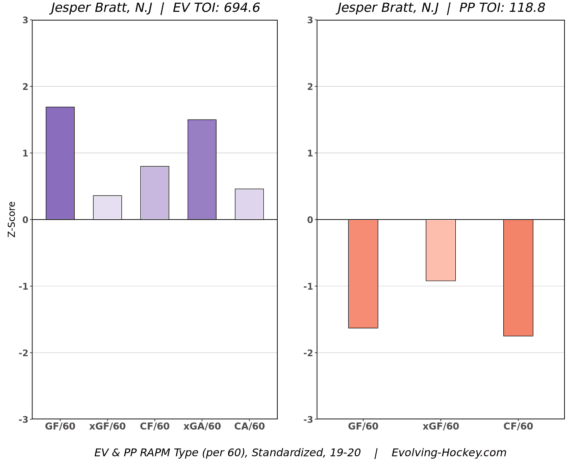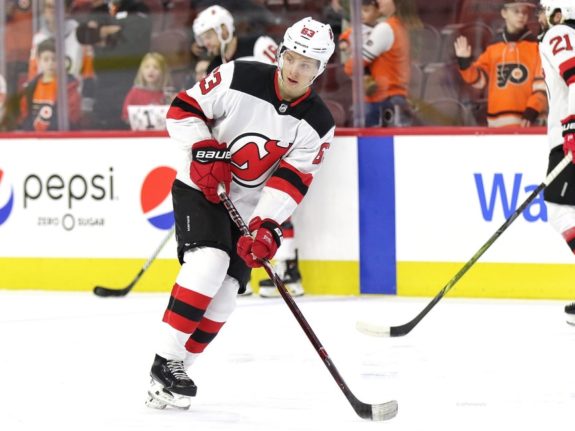Expectations were quite high for New Jersey Devils’ winger Jesper Bratt entering the season. He only played in 51 games in his second pro campaign in 2018-19 but produced at a 52-point over 82 games. The hope was he’d continue building on that step forward in 2019-20, but that’s not how things started out. He totaled seven points in his first 21 games and found himself on the fourth line under then-head coach John Hynes.
But things changed when Hynes was let go by the Devils on Dec. 3. Since Alain Nasreddine took over as the interim HC, Bratt has looked like the player he did towards the end of the 2018-19 season. He has 12 goals and 25 points in his last 38 games, a 25-goal and 53-point pace over 82 games, and has solidified himself as one of the Devils’ top scoring threats who they can build around this offseason.
Bratt’s Remarkable Turnaround
It wasn’t a pretty start to the season for Bratt by any stretch. It began with him on the Devils’ second line with Nikita Gusev and Jack Hughes, the first overall pick in 2019. But that was shortlived after a tough first outing against the Winnipeg Jets in the team’s season opener.
From there, Bratt struggled to find his footing under Hynes. He was playing on the Devils’ fourth line on many nights and struggled to produce offense without scoring threats alongside him. His struggles were evident in his five-on-five numbers, as the Devils had a Corsi share (CF%) of 47.96% and expected goals share (xGF%) of 44.86% with him on the ice.

But despite the poor on-ice stats, Bratt was still averaging 1.92 points per 60 minutes (points/60) in limited ice time. So the signs were there for a potential breakout if put in the right situations, and that’s come to fruition in a big way since the coaching change.
Since Dec. 3, Bratt has been the Devils’ most efficient scorer, averaging 2.42 points/60. His CF% has improved to 48.98%, while xGF% has seen a massive jump to 53.23%. He’s also averaging the second-most shots on goal/60, and fourth-most individual expected goals/60, at five-on-five. His defensive game has seen some much-needed improvement from where it was a year ago, and even the beginning of this season. The result is him having a strong, positive impact at both ends of the ice at even strength.

There was a time when Bratt’s even strength RAPM had a similar negative look to his power play RAPM. But his drastic improvement at that game state has turned him into one of the team’s best two-way forwards. It also helps that he’s no longer stuck in a grind-it-out role on the fourth line. And that may be the biggest reason why he’s come to life over the last 38 games.
Bratt Producing Anywhere in Devils’ Lineup
Part of what makes Bratt so explosive is his makeup as a modern, NHL winger. He’s only 5-foot-10, 174 pounds, but he’s a strong skater with a great set of hands. His elusiveness with the puck on his stick is second to none on the Devils too. And that’s why sticking him on the fourth line earlier in the season did more harm than good.
Related: Devils Improved Prospect Pool Through Trades
But since Nasreddine took over, Bratt has played in a top-nine role or better almost every night, except for an unwarranted healthy scratch against the St. Louis Blues a couple of weeks ago. When the coaching change occurred, Bratt immediately began on the top line with Kyle Palmieri and Nico Hischier. And they fared well, as the Devils had an xGF% above 57% and outscored their opponents 10-2 with them on the ice.
It’s been a few weeks since we’ve seen that combo, but Bratt has found success with his new linemates, Gusev and Pavel Zacha. The Devils have a CF% over 53%, as well as an xGF% over 51%, with them on the ice. Gusev has been on a tear since the formation of that unit, as he has 10 points in his last nine games. Zacha has also started producing, with six points in his last nine games, although his output is more a result of them producing as a power play unit rather than at even strength.

What’s important to note is Bratt is producing in different spots of the lineup. In season’s past, he had trouble performing when not alongside some of the team’s top players, such as Taylor Hall or Hischier. He’s not the play driver Hall was, but he’s been carrying the line of Gusev and Zacha. And with his improved play, it looks like he’s at the point where he can produce anywhere in the Devils’ top nine.
Related: The Best Team in Devils Franchise History
That is what makes Bratt a bright spot for a Devils’ organization that fired their head coach, their general manager, and traded their best player away within almost 40 days of each other. There were questions if he could handle top-six minutes heading into the season, and that looked like a reasonable doubt through the first 20-plus games. But those concerns have been eased significantly, and it now looks like he’s one piece — along with Hischier and Hughes — the Devils can build around to be competitive in 2020-21.
* * *
Advanced stats from Natural Stat Trick, RAPM chart from Evolving Hockey